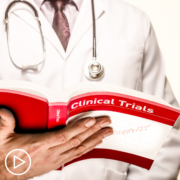Managing Life With AML | What You Should Know About Care and Treatment
Managing Life With AML | What You Should Know About Care and Treatment from Patient Empowerment Network on Vimeo.
What do you need to know when it comes to managing life with acute myeloid leukemia (AML)? In this webinar, Dr. Alice Mims, an AML specialist and researcher, discusses how treatment decisions are made and how test results may impact therapy. Dr. Mims will shares the latest advances in research and key advice for living well with AML.
Dr. Alice Mims is a hematologist specializing in acute and chronic myeloid conditions. Dr. Mims serves as the Acute Leukemia Clinical Research Director at The Ohio State University Comprehensive Cancer Center – James. Learn more about Dr. Mims.
Related Resources:

|

|

|
Transcript:
Katherine Banwell:
Hello, and welcome. I’m Katherine Banwell, your host for today. Today’s program is a continuation of our Thrive series. And we’re going to discuss navigating life with AML, and how you can engage in your care. Before we get into the discussion, please remember that this program is not a substitute for seeking medical advice. Please refer to your healthcare team about what might be best for you. Well, joining us today is Dr. Alice Mims.
Dr. Mims, welcome. Would you please introduce yourself?
Dr. Alice Mims:
Yeah, sure. Thank you, Katherine. I’m Alice Mims. I’m a physician and associate professor at Ohio State University. And also, the section head for the myeloid and acute leukemia program within our division of hematology.
Katherine Banwell:
Thank you so much for taking the time to join us today, Dr. Mims. We start all of our webinars in our thrive series with the same question; in your experience, what does it mean to thrive with AML?
Dr. Alice Mims:
Sure, I think that’s a great question. So, really for me, I think thriving with AML is very patient- or person-dependent. It really depends on making sure that your treatment goals align with your care. And so that means really being an active participant in your diagnosis, understanding the disease process, and making sure that your care team really understands what your overall goals are for your treatment.
Katherine Banwell:
Thank you for that because it helps us to understand as we move through the program today. One part of thriving with AML is finding a treatment approach that manages your disease and fits with your lifestyle. Before we talk about therapy, can you tell us how treatment goals are established for an individual patient?
Dr. Alice Mims:
Sure. So, for individual patients I think it’s very important that there is an initial discussion that doesn’t feel too shortened that you can have time with your care team to really go into depth about the diagnosis, about the specifics of your particular subtype of acute myeloid leukemia, understanding the treatment options, and then being given time allowed to reflect on all of that information. So, then you can come back and have your questions better answered that may come from that initial discussion.
And then help you with your team make a decision based on that information that works best for you.
Katherine Banwell:
Outside of patient preference, what other factors do you take into account when working with a patient to decide on a treatment plan?
Dr. Alice Mims:
Sure. So, there are multiple different factors that we try to take into account. Again, yeah most importantly what patients’ goals are like you mentioned, but those include overall health, including different comorbidities, so what other healthcare diagnoses, medications are you taking, what are the patient’s age, thinking about that for long-term goals, overall support from loved ones, family to — just because care can be really involved. And then in particular, thinking about specific features of that individual patient’s AML, including molecular, genetic features of the leukemia.
Katherine Banwell:
Well, let’s talk more in depth about the test results you just mentioned.
What is the test for genetic markers? And how is it conducted?
Dr. Alice Mims:
So, there are a few different tests that we use under that scope of genetic markers. So, those include looking at chromosomal abnormalities of the DNA. So, with cytogenetics, and then also more specific prose where we call FISH testing. And then also we look for specific gene mutations through next generation sequencing, or PCR testing. And so, we use all of those results together to give us the most information we can about that individual’s leukemia.
Katherine Banwell:
How has molecular testing revolutionized AML care?
Dr. Alice Mims:
Oh gracious. It’s really done such – so much for leukemia. And just things are so different even where they were five years ago because of having molecular mutations, that information available.
So, it helps with discussing prognosis. So, we know that different molecular features can tell us about curative intent and what are the treatment steps we would need to take to give the best chance long-term. And then also now, we’ve evolved to where we have directed therapies that can target mutations or the proteins that arise from those mutations with therapeutic options.
Katherine Banwell:
Is this testing standard following an AML diagnosis?
Dr. Alice Mims:
It is standard following an AML diagnosis. That’s recommended within all of the guidelines with patients and really should be done for all patients at initial diagnosis.
Katherine Banwell:
Can genetic markers or mutations change over time? For example, if a patient relapses, should molecular testing be done again?
Dr. Alice Mims:
Yes, absolutely. Mutations can evolve. It’s something we call clonal evolution of the leukemia.
And so you can have mutations that could be present at diagnosis that may no longer be present. Or the opposite can occur where you have new mutations that can appear. And that can lead to different options for treatment. So, it’s very important to retest at time of relapse.
Katherine Banwell:
What advice do you have for patients who want to ensure that they’ve actually undergone molecular testing? What questions should they be asking their healthcare team?
Dr. Alice Mims:
I think it’s definitely important to bring this up with the healthcare team. And it should be something at diagnosis and relapse to ask, what are the cytogenetics, what do they look like now, what do the gene mutations, and really as mentioned before, it’s so crucial in talking about prognosis, talking about treatment options that if it doesn’t come up, it’s really something that you should take a pause and try to go back to readdress with your team.
Katherine Banwell:
I’d like to move on to treatment now, Dr. Mims. And, of course, treatment takes place in phases for AML. The first is induction therapy. Can you start by defining induction therapy for our audience?
Dr. Alice Mims:
Sure. So, induction therapy is really terminology that we use to talk about initial therapy for someone with a new diagnosis. So, we can have intensive induction therapies, and non-intensive induction therapies. But the goal for either of those types of treatment is to get the leukemia into remission.
So, to talk about that in a little bit more detail, for intensive induction regimens, those typically involve cytotoxic chemotherapy. So, you may hear terminology like, “7 + 3 induction,” or “high-dose cytarabine regimens,” but those are typically more intensive regimens that we use that can have increased side effects but may be very important based off the type of acute leukemia.
And then for non-intensive based regimens, one of the standards has really evolved to be venetoclax (Venclexta) and azacitidine (Vidaza) as a non-intensive regimen that can work very well for a majority of patients. And there are some off shoots of that as well.
Katherine Banwell:
Okay. And when does stem cell transplant come into play?
Dr. Alice Mims:
Sure. So, stem cell transplant is something that we all think about at the beginning for anyone with a new diagnosis of acute myeloid leukemia where as we’re working to get back genomic information about the individual’s acute leukemia, we may go ahead and start looking for different donors, doing typing, just in case that’s something that we need as far as someone’s therapy.
But typically we reserve stem cell transplant for patients who have either intermediate or high-risk features of their AML. Or who may have even favorable respite are not responding as well as we would like when looking at the depth of remission. And so, we always want to be prepared in case that’s something we need to move forward with as part of their care, if the goal of their treatment is for curative intent.
Katherine Banwell:
Let’s talk about what happens after the initial phase of treatment. What’s the purpose of consolidation therapy?
Dr. Alice Mims:
Sure. So, there are a few different purposes we can use consolidation therapy for. So, for patients – consolidation therapy is used for patients who have achieved remission. And then it’s either to try to hopefully get them cure of their AML. The patients have more favorable risk features of their AML and cure is an option through just chemotherapy alone.
Or it can be used to try to keep people in remission while we’re working to get towards stem cell transplant as that can sometimes take a few months to get a donor ready, have things ready to move forward with transplant.
Katherine Banwell:
And what are the options for consolidation therapy?
Dr. Alice Mims:
Sure. So, options for consolidated chemotherapy are typically based off of what you had initially for induction chemotherapy. So, if it’s more intensive-based regimens, it typically is consolidation with intensive consolidation, cytarabine based regimens.
For lower intensity regimens, typically consolidation is more continuing therapy on what you started but may have adjustments of the treatment based off of trying to decrease the toxicity now that the patients are in remission.
Katherine Banwell:
And how are patients monitored in consolidation therapy?
Dr. Alice Mims:
Sure. So, it definitely is based off of the individual’s type of consolidation chemotherapy or treatment. But most patients, if we feel like the treatment is going to lower blood counts, they have bloodwork twice a week, and we’re watching for things, for side effects for treatment, looking out for risk of infection, giving transfusion support, and then if something happens that we feel like we can’t support patients in an outpatient setting, then we’ll get them back into the hospital if they need to for care.
Katherine Banwell:
What side effects are you looking for?
Dr. Alice Mims:
So, most of the side effects with any of the treatments that we give are what we call myelosuppressives. So, it lowers the different types of blood counts.
So, white blood cell count which increases risk of infection, red blood cells, so, side effects or symptoms from anemia. And then risk of bleeding from low platelet counts.
Katherine Banwell:
Okay. Maintenance therapy has become more common in other blood cancers particularly in multiple myeloma. Is there a role for maintenance therapy in AML?
Dr. Alice Mims:
There actually is now, which is something that’s newer that has evolved for acute myeloma leukemia. So, in the context of intensive therapy, we now have oral azacitidine (Onureg), which is a little bit different than some of the IV formulations that we give.
But for patients who receive intensive induction therapy, get into remission and may receive consolidation but are not able to go onto transplant if they have that immediate or higher risk features, there’s FDA approval for oral azacytidine, which has been shown to improve overall survival and keep people in those remissions for longer.
More recently, specifically for patients who have a particular type of mutation called FLT3, if they also receive intensive induction therapy with a FLT3 inhibitor added onto that, then their quizartinib was just recently approved as a maintenance therapy for patients with that particular type of AML.
Katherine Banwell:
Are there emerging AML therapies that patients should know about other than what you just mentioned?
Dr. Alice Mims:
Sure. So, I think there are a lot of exciting treatments that are up and coming based off of many small molecule inhibitors that are being studied.
One in particular I would mention that everyone’s very excited about is a class of agents called menin inhibitors.
And so that’s an oral agent that has been shown to have responses for patients with relapse or refractory AML who have NMP-1 mutations or have something called KNT2A rearrangements. And seeing responses with just a single agent in the relapse refractory setting, it’s been really exciting. And so, I think we’re hopeful that that may become FDA-approved in the near future. And it’s also now being explored in combination with intensive chemotherapies as well as less intensive induction regimens. And so, maybe we can do a better job without brunt treatment by adding these therapies on.
Katherine Banwell:
That’s exciting news. When it comes to living and thriving with AML, Dr. Mims, managing disease symptoms and treatment side effects is a big part of that.
Would you talk about how symptoms and side effects can impact life with AML?
Dr. Alice Mims:
Sure. So, I think from my perspective, what we are always trying to do when we’re moving forward with a treatment plan is of course, get patients into remission, but the purpose of getting into remission is not just to achieve that, but for patients to have quality of life. And so, there needs to be continued dialogue between the patient and the treatment team about how you’re feeling during treatment. Because they’re definitely based off of therapy, different side effects, things that could be not necessarily due to active leukemia anymore. And so there may need to be dose adjustments and other things that we do to the regimens in order to make you feel as good as possible while continuing on treatment.
Katherine Banwell:
Why is it so important for patients to speak up about any issues they may be having?
Dr. Alice Mims:
I think it’s important because you’re your own best advocate. Being the patient, being the person who’s living with having this diagnosis and going through the treatment, myself, or other colleagues as physicians, we can have a sense of what may be going on based off of numbers. But we’re not truly going to know how you’re feeling unless you speak up and let us know. And there may be things we could do with supportive medications, dosing adjustments as mentioned, that could help in making you hopefully feel better and less side effects and toxicities from treatment.
Katherine Banwell:
What are some common symptoms and side effects that you hear about?
Dr. Alice Mims:
Okay. Sure. So, different side effects that I would say that people can have, people can feel fatigued just from treatment in general. Some of our therapies can cause neuropathy, skin rashes, nausea, vomiting, diarrhea. And so, all of those are important along as mentioned with symptoms you may have from decreased blood counts that we do have interventions that we could implement to help the – make the therapy more tolerable.
Katherine Banwell:
So, for the side effects like fatigue for example, what do you do about that?
Dr. Alice Mims:
So, I think it depends on the level of fatigue. Of course, we don’t have – I wish we had a pill that could just make fatigue improve. But if it’s really that the treatment is deriving it, and it’s impeding your quality of life there are dose reductions or things we can do that may help with the level of fatigue you’re experiencing.
Katherine Banwell:
And what about some of the other side effects. You mentioned diarrhea.
Dr. Alice Mims:
Sure.
Katherine Banwell:
How is that handled?
Dr. Alice Mims:
Yeah. So, for issues from GI complications such as nausea, vomiting, diarrhea, we have really lots of choices for anti-nausea medicines and different combinations we can use or newer antiemetics that can help with that. And from a diarrhea perspective it depends on the treatment. But of course, we want to make sure first and foremost there’s no infection. And if not, then there are good antidiarrheals we could add on to the regiment to help with that as well.
Katherine Banwell:
Okay. That’s great advice. Thank you. I want to make sure that we get to some of the audience questions. These were sent to us in advance of the program today. Let’s start with this one; Janet wants to know what factors enable a patient to achieve and continue in remission if they are not able to achieve stem cell transplant due to age restrictions.
Dr. Alice Mims:
So, I think first and foremost, I think it’s very important that there — that patients are aware that there shouldn’t be just strict, stringent cutoffs of age as a requirement for stem cell transplant. And really, there’s a lot of research going on that we should take into account. Physiological age, and there’s ways to measure that just to be sure that stem cell transplant really is not an option. And for patients who stem cell transplant is not an option, I think as we talked about earlier, so there can still be really great treatments that can get patients into remission and ongoing therapies with dosing adjustments again to decrease toxicity and improve quality of life and thinking about things like maintenance therapy as appropriate.
Katherine Banwell:
What are the age restrictions, and why are they there?
Dr. Alice Mims:
So, sometimes you will hear age 75.
Really, no one above age 75 should move forward with transplant. And that’s based off of past data where they’ve explored transplant and seen increased toxicity. And from transplant in itself, increased side effects, increased risk of early mortality. And so, I do think it’s important to take the patient as a whole into consideration because again, you could have someone who’s 77 who may be running marathons, and in great shape, and not a lot of other healthcare issues, who may still do really well with treatment. And so, I think that’s – really needs to be taken in account, really the overall picture of health for the patient before making…
Katherine Banwell:
So, the…
Dr. Alice Mims:
…just a firm cutoff.
Katherine Banwell:
Right. Okay. So, it’s not cut and dry.
Dr. Alice Mims:
Exactly.
Katherine Banwell:
If you’re 75 or older, then you definitely can’t have stem cell transplant.
Dr. Alice Mims:
That’s correct.
Katherine Banwell:
Then you’re looking at everyone individually.
Dr. Alice Mims:
Yeah. So, it really should be looked at.
And I still have some patients who will come to me and say, “Oh, I was told I’m 68 years old, I’m not a candidate.” And that always makes me take a step back. And then we kind of have to have that discussion again. And they may still not be a good candidate based off of other comorbidities or healthcare issues, but it shouldn’t just be a number rules you out for having that as an option.
Katherine Banwell:
Good to know. We received this question from Carl, “What does treatment look like following transplant? And what are doctors looking for when monitoring through blood tests?”
Dr. Alice Mims:
Sure. So, after transplant, the first three months is pretty intensive of being seen very frequently at your transplant center twice to once a week. You’re also on immunosuppressive medications to try to help prevent issues like graft vs host disease, which can be a complication from transplant.
And then over time if you’re doing well, we try to start tapering off those immunosuppressive regimens to see if you can tolerate that. And what I say to most of my patients for – who are undergoing transplant, it can take some time to really feel back to being yourself. It can take six months, it can take a year or longer. And sometimes your normal is a new normal based off of how you do and the side effects of the transplant in itself. So, you may not go back to if you’re here before transplant and before your diagnosis, it may be that this is your new normal. Just so people can be prepared and know what they’re signing up for.
Katherine Banwell:
And with the blood testing, what are you looking for when you’re monitoring a patient?
Dr. Alice Mims:
Sure. There are a few different things that we’re looking for when monitoring patients. So, one, making sure that the stem cells or the graft from the donor are recovering.
You want to see that blood counts, levels of white blood cells, red blood cells, platelets are getting to normal levels. You’re also assessing and making sure you’re not seeing signs of relapse. You’re checking levels of donor cells versus the patient cells within the stem cell — sorry, within the stem cell compartments. And so, we’re taking all of those into account as well as checking organ function and making sure there’s no signs of potential graft versus host disease as well.
Katherine Banwell:
Katrina sent in this question; do you have any advice for dealing with a general oncologist who does not exactly follow my AML doctor’s recommendations? I see a local oncologist and an AML specialist guides my care.
Dr. Alice Mims:
I think that’s a tough question. And so, I think I’ll answer that if – maybe two different ways.
So, one, I think sometimes it’s hard when you’re the local community oncologist, and you’re there for the day-to-day care. And so there may need to be treatment adjustments and other things that you need to do in that moment or time to help make sure that toxicities are not too severe or are helping the patient as you’re seeing them day-to-day. And it may not be easy to involve the specialist right there in the moment. But I think if there are bigger issues as far as overall goals, overall communication, it should be that both are able to communicate well with each other. They should be able to communicate via email, via text message. That’s what I do with a lot of my community partners. And it’s always important that you as a patient feel confident in your care. And so, if that trust is not there that things are being followed, then it may be important to look and see if there’s another physician who you do feel comfortable with proceeding with your care with.
Katherine Banwell:
And what do you tell patients when they’re not feeling comfortable with their care team or their oncologist or their general oncologist? What do you say to them to give them some confidence to find somebody else who they feel more comfortable with?
Dr. Alice Mims:
Sure. So, I’ll just say from my perspective. So, if I’m seeing a patient and they may have questions, they may not feel comfortable, they may need more time. And I always think it’s important if you want a second opinion, whether it’s at a specialist level, whether it’s in a community oncology private setting, that should not be offensive to the physician.
If that makes the patient feel more comfortable in what they’re doing with their care, that’s how they should move forward. And it should be what they feel like is best. If a physician takes that personally or is offended by it, I think that’s more of their problem as opposed to anything that you’re doing wrong.
Katherine Banwell:
Okay. Thank you for that. Ryan wants to know; I’m a year and a half post-transplant, how can you tell if the aches and pains in your joints are normal aging, host vs graft disease, the AML returning, or even something else?
Dr. Alice Mims:
So, I think that’s also a difficult question to answer because it really is patient dependent. And so, I think if you’re having new joint aches or pains, it’s always important to reach out to your transplant team to make sure that – it could be any of the above..
And so you’re doing the appropriate workup with lab work, imaging, things that would be appropriate or seeing certain specialists. Maybe orthopedist if needed because it could be I’d say less likely leukemic relapse, but still want to be sure. But it could be definitely complications from GVHD or there’s some joint issues that can evolve post-transplant, especially for people who are on long-term immunosuppressant medications. Or it could be the normal effects of aging. So, it’s always good to have that reassurance.
Katherine Banwell:
Let’s talk a little bit about mental health resources. Managing the worry associated with a diagnosis or concerns about relapse, or even various side effects can lead to emotional symptoms like anxiety and fear.
Why is it important for people with AML to share how they’re feeling with their healthcare team?
Dr. Alice Mims:
So, I think it’s very important because, one, all of those feelings are normal feelings. I think they’re sometimes that from going through such a rapid diagnosis and then having to start treatment pretty quickly and going through all the ups and downs with these types of diagnosis can really lead to for some patients PTSD-type symptoms. And then there are also things that can evolve over time where their anxiety or even survivorship guilt as you go if you move forward and are doing well where you may have some friends or people you met along the way who may not have had as good outcomes. And so, there are resources available based off of where you are.
But for survivorship, oncology specific counseling to deal with some of these feelings that are understandable and normal for what patients have been through.
Katherine Banwell:
Can a social worker help? And are there other people on the healthcare team who can support a patient’s emotional needs?
Dr. Alice Mims:
Oh, absolutely. So, I think it’s really place-dependent on where you are but yes, absolutely. Social workers are a great resource for patients. There may be other collaborative teams based off of where you’re receiving your treatment that may be available that are maybe patient support groups where you can go and be with other patients or Facebook, social media support groups. And I think all those can be very helpful. And I know at least at our center, we also have patient mentors who have been through and gotten through to the other side of transplant or whatnot who are great resources because they’ve lived and experienced it.
And I think that’s just as a physician, I can talk about things that I don’t have that personal experience having lived through it. And I think that’s very important —
Katherine Banwell:
Yeah. It’s a…
Dr. Alice Mims:
…to be able to have somebody to talk to. Yeah.
Katherine Banwell:
Yeah. What about the financial aspect of treatments? There are many people who would find it difficult to find and maybe they don’t have insurance, or their insurance doesn’t cover a lot. How do you help patients who are dealing with financial restrictions?
Dr. Alice Mims:
Sure. So, I think that we’re fortunate here because we have a lot of support staff to help patients with our financial counseling team. We also have people within the medication assistance programs who can help find foundation grants to help with medication support, travel support.
I think for patients who may not have those things available at their individual center, The Leukemia & Lymphoma Society is a great place to reach out for.
And there are other foundations as well who at least may have navigators to help patients figure out other resources or funding available.
Katherine Banwell:
Yeah. Okay. That’s really good information, Dr. Mims. Thank you. And please continue to send in your questions to question@powerfulpatients.org and we’ll work to get them answered on future programs. Well, Dr. Mims as we close out our program, I wanted to get your thoughts on where we stand with progress in AML care. Are there advances in research treatment that you’re hopeful about?
Dr. Alice Mims:
Yes. I would say from even when I finished fellowship 10 years ago, not to state my age, but we had essentially about three treatments at that time.
Now in the past five years there have been I think maybe 11 different new drugs that have been approved for a acute myeloma leukemia. And so, I think we’re just on the precipice of really evolving to have individualized care. Hopefully have more curative options for patients. So, I’m really excited for the time we’re in right now where I even hope we’ll be in the next five years for patients.
Katherine Banwell:
That’s an encouraging message to leave the audience with, Dr. Mims. Thank you so much for joining us today.
Dr. Alice Mims:
Thank you so much for letting me be here with you today.
Katherine Banwell:
And thank you to all of our collaborators. To learn more about AML and to access tools to help you become a proactive patient, visit powerfulpatients.org. I’m Katherine Banwell. Thanks for joining us today.










